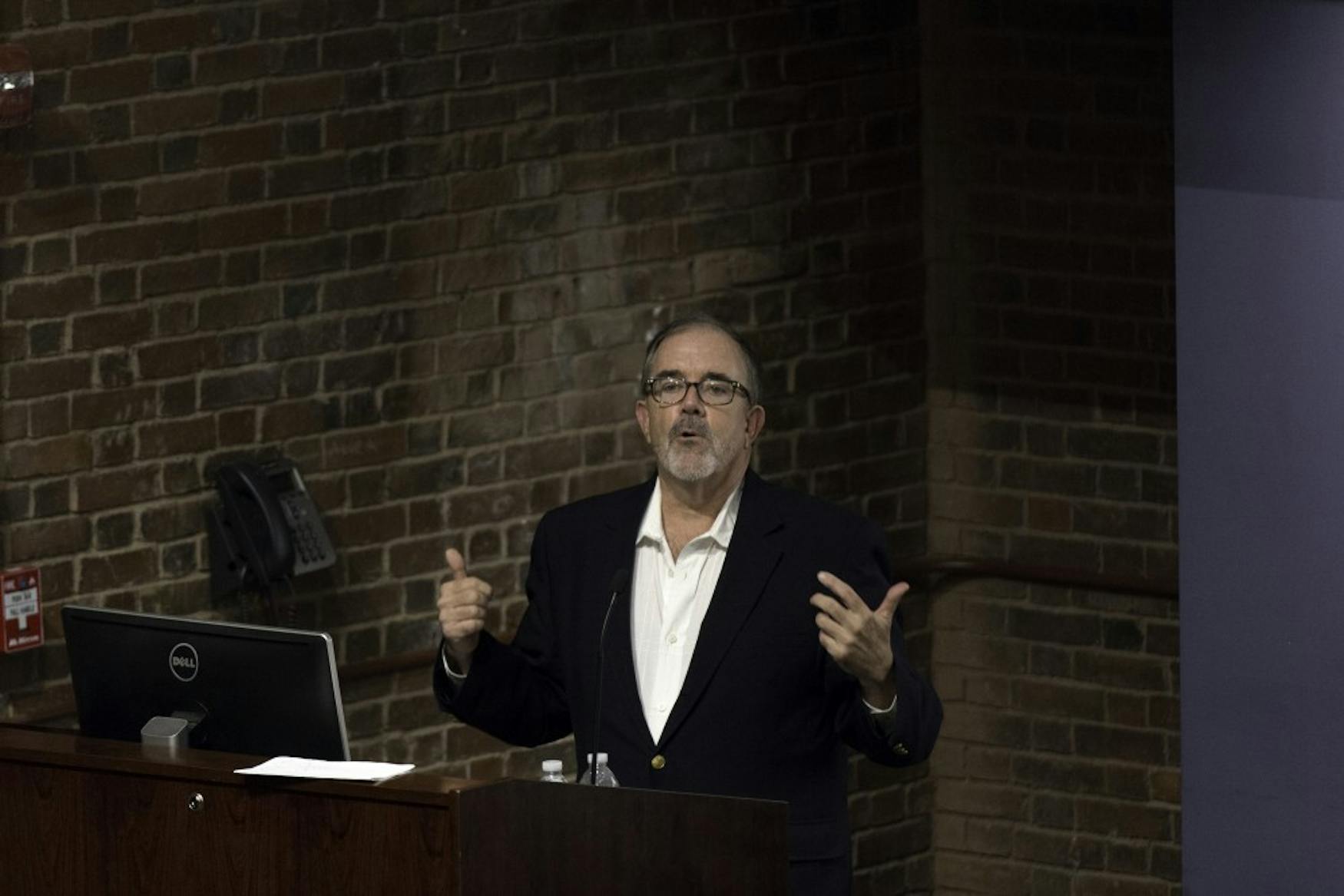Biographer reviews Nixon’s relationship with TV and the press
Five decades ago, President Richard Nixon began a political comeback which culminated in his presidential election in 1968. It wasn’t an easy feat: Nixon had an antagonistic relationship with both the press and himself, as journalist and biographer John Farrell discussed in a presentation on Tuesday.
Nixon’s political career involved extreme highs and lows, Farrell explained. Nixon went from political glory during the Red Scare in the 1950s to a crushing electoral defeat in 1960, and then around again with his victory in 1968 and the subsequent Watergate Scandal.
Nixon knew his career was driven by the press, Farrell said: “He had gone from House freshman to vice president of the United States in six years, basically because of exceptionally favorable notices.” Farrell claimed that throughout every major event in Nixon’s career — both good and bad — the press became so excited at times that they didn’t maintain their “professed standards of objectivity.”
Nixon’s successful Congressional campaign in 1946 was due to favorable coverage by the conservative New York Herald and the Los Angeles Times, according to Farrell. He was “the darling” of the family who owned the latter paper, and his campaign took out expensive ads in other local papers. Farrell said Nixon learned from this experience that “the game was rigged—” favorable articles could be bought.
Nixon’s relationship with the press was further complicated by his role in exposing Alger Hiss as a communist spy in 1948. Hiss was a government official beloved by liberals, and Nixon led the House UnAmerican Activities Committee in investigating him. Liberal papers such as the New York Times had supported Hiss against HUAC, and they published scathing opinions of the affair.
Nixon was angry at the liberal press for their treatment of him, and Farrell said that anger “stayed with him and never went away.” Even years later, Nixon saw himself as a hero for exposing Hiss and harbored a deep resentment that some papers didn’t portray him that way — even though many conservative ones did.
Nixon’s resentment at the press’ portrayal of him was compounded by his own insecurities, Farrell said.
According to Farrell, Nixon referred to himself as “the sourpuss brother.” He’d had a difficult childhood, with a distant mother and an emotionally abusive father. He came to see himself as unlovable, and was constantly telling himself, “You’re no good. They don’t like you.”
Farrell explained that he sees Nixon’s antagonistic relationship with the press as intricately linked to his insecurities; Nixon’s social awkwardness combined with his paranoia and his personal experiences with the media until, to him, “The press [was] the enemy.”
In 1952, a political opponent accused Nixon of having a secret slush fund, and the liberal press jumped on it. To save his reputation — and his spot as vice president on the Republican ticket — Nixon delivered a speech on television. Farrell said that his infamous “Checkers Speech” showed Nixon how far TV could reach: He could reach an audience without talking to any reporters. And Nixon was in awe.
Farrell believes that Nixon used television as a way of evading the press. After the successful speech — which took its name from Nixon’s dog, a gift from a supporter — Nixon didn’t worry about reporters not showing up for press conferences. “Fuck it,” he’d say, “We don’t need them.”
In 1960, Nixon had to compete with John F. Kennedy for the press’ attention, and Kennedy easily won reporters’ adulation. Farrell explained that some reporters viewed assignments to cover Kennedy as an honor, while reporting on Nixon was a hated chore.
Their preference wasn’t a secret, and Farrell cites the 1960 election cycle as the beginning of “the conservative lament that right-wing candidates face the bias of the liberal media.”
After losing the race for California governor in 1962, Nixon held what he claimed would be his final press conference. Bitter that the LA Times’ new editor wouldn’t use the paper as a conservative mouthpiece, Nixon told the press they would miss having him to kick around.
Farrell cited a few events which enabled Nixon’s triumphant return on the 1968 Republican ticket: Barry Goldwater’s disastrous 1964 presidential bid, Robert Kennedy’s and Martin Luther King’s assassinations, and the ongoing Vietnam War.
Nixon attempted to portray himself as a new man in 1968, but “Tricky Dick was still Tricky Dick,” Farrell said. Decades after his first clashes with the media, Nixon was still paranoid, evasive and self-deprecating. In the spring of 1973 a former publisher of the LA Times, Norman Chandler, was dying. Nixon’s staff twice told Chandler that Nixon was coming to pay his respects, and Nixon twice declined to show up. His resentment ran deep.
Farrell compared Nixon to President Trump, another president who “[based] his campaign on resentment … and [declared] over and over again, ‘The bankrupt New York Times,’ and … ‘The press is your enemy.’”
Farrell concluded by telling students to understand the dual forces of ire and retaliation.
They go back and forth over a period of years, he said, and end in an American tragedy.



Please note All comments are eligible for publication in The Justice.